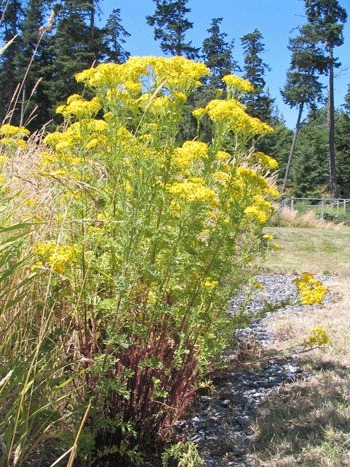Part 3 in a series of articles on how to recognize, combat and eradicate noxious weeds:
By San Juan County Noxious Weed Control Program staff
It’s a sign of summer: we’re starting to find dead tansy ragwort (Senecio jacobaea) plants along the county’s roads, left there by alert residents aware of the plant’s hazards and status as a Class B noxious weed – meaning that landowners are legally obligated to keep it from spreading.
The best time to dig out tansy is before the bright yellow, daisy-like flowers open. Once the yellow shows, however, the flowers can set seed and be carried along by vehicle tires to new locations.
After the yellow flowers begin to open, it is necessary to cut the heads off the plants and bag them, leaving the non-flowering parts behind.
Tansy is easily recognized when in flower. No other locally common member of the daisy family has bright yellow flowers with thirteen petals and soft frilly leaves, coupled with an unpleasant odor when crushed or pulled.
Depending on conditions, the plant may reach a height between a few inches and more than five feet. Because of last summer’s early rains and the mild wet winter and spring, tansy will be abundant again this year.
Tansy ragwort is one of our worst weeds. Highly toxic, it accounts for more livestock deaths in San Juan County than any other weed. The toxin is cumulative and causes irreversible liver damage.
While horses and cattle will normally avoid tansy in pastures, it loses its characteristic odor when dry in hay. At that point, animals cannot distinguish it from the rest of the forage. Animals can also accidentally ingest leaves of the first-year rosettes.
Sheep and goats show some resistance to the toxin, but it may taint the milk and, possibly, the meat. Because of the threat to livestock, every attempt must be made to find and remove all tansy from pastures and hayfields, as well as roadsides and other areas from which it can spread into agricultural lands.
When the plants flower they can be pulled by hand; the flowers then should be removed and bagged. In pastures and hay meadows the entire plant should be bagged.
Selective herbicides may be used to spot-spray individual plants without harming the grass around them. Remember that when using herbicides, always follow label instructions. The label is the law.
For specific herbicide recommendations, contact the County Noxious Weed Control Program at 376-3499. County ordinances prohibit the use of herbicides on any public right-of-way.
Mowing can only be used as a stop-gap solution for tansy control, since the plants will re-bloom during the same season, and then reappear as robust, short-lived perennials in succeeding seasons.
Biological control — using a combination of cinnabar moth caterpillars, a root-feeding weevil, and a seed-eating fly — shows some promise. The caterpillars, however, may eat closely related members of the same genus (although they do not appear to cause serious damage) and are therefore no longer being distributed in San Juan County.
The weevil and the seed-head fly are host-specific. Biological control of any weed takes an investment of years, however, before results can be gauged.
For more information on tansy ragwort or other noxious weeds, call the County Noxious Weed Program or email rich@sanjuanweeds.org, or judy@sanjuanweeds.org. Specialists can be hired to help with removal on your property.
— Editor’s note: Read Part 1 of this series, “Battle begins with the ‘Broom’, in the June 20 edition of the Journal, pg. 7; Part 2, “Poison hemlock: history of fatal proportions, July 4 edition, pg. 14, or online at, SanJuanJournal.com.




